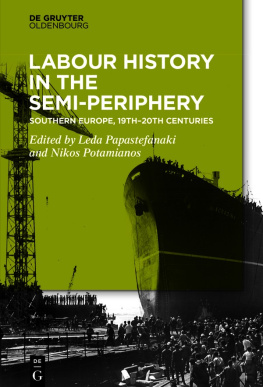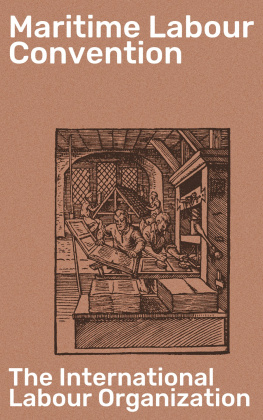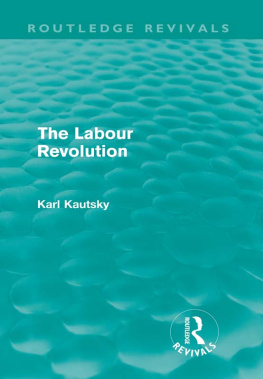ISBN 9783110614282
e-ISBN (PDF) 9783110620528
e-ISBN (EPUB) 9783110617818
Bibliographic information published by the Deutsche Nationalbibliothek
The Deutsche Nationalbibliothek lists this publication in the Deutsche Nationalbibliografie; detailed bibliographic data are available on the Internet at http://dnb.dnb.de.
2021 Walter de Gruyter GmbH, Berlin/Boston
List of Illustrations
Tables
: | Number of enterprises per hundred inhabitants, per hundred workers and number of industrial enterprises (including construction) per hundred workers and per hundred industrial workers in 2011. |
: | Respective shares in Europe of independent employment in the national economy, Transformation, Construction and Industry (including construction) in 2014 (in %). |
: | Unpaid family employment in the working population of some European countries, in 2008 and 2014 (in %). |
: | Distribution of female and male professional status in the EU28 in 2014 (in %). |
: | Female employment in industry (excluding construction) and distribution of female and male employment by professional status (in %). |
: | Distribution of industrial companies (excluding construction) by size in Europe in 2013 in %, based on number of enterprises, number of employees, turnover and added value. |
: | Distribution by legal form of industrial enterprise (excluding construction) in Europe in 2007 (in %). |
: | Distribution of Greek industrial companies (excluding construction) by size and by legal form, in 1988 (in %). |
: | Number of employees and footwear production in the period 19311941 for the Bata Company in Yugoslavia. |
: | Factory and auxiliary buildings in 1945. |
: | Residential and public buildings in Borovo and their surface in 1945. |
: | Main welfare facilities in Italy in 1923, as provided by eight hundred and seventy-five industries with over one hundred employees. |
: | Main welfare facilities in Italy in 19311933, as provided by four hundred and sixty-seven companies of every size, in the industrial and tertiary sectors. |
: | Main welfare facilities in Italy in 19541955, as provided by one hundred and seventy-four small, medium and large industrial companies, differentiated by production sector (in %). |
: | Proposed degrees for ship engineers. |
: | Ingenieros Navales plan of studies. |
: | Collective bargaining for Naviera Vizcana S. A. Bilbao, 1974. |
: | Collective bargaining for CAMPSA, 1980. |
: | Number of permanent employees at Palermo shipyard (sub-contract and fixed-term workers not included), 19511970. |
: | The composition of the shipyard Internal Commissions from 1954 to 1969. |
Figures
Figure 8.1: | Plan of Borovo. |
Figure 8.2: | Standard double flat house in Borovo. |
: | Entrance to the Factory area, 1933. |
: | Workers in Borovo, 1933. |
: | Factory restaurant in Borovo, 1933. |
: | Company town in Borovo, 1935. |
Figure 10.1: | The colleges of probiviri in Italy, 1912. |
: | Engine room officers and cadets posing for a picture. Compaia Trastlntica, c. 1910. |
: | First Engineer at work, 1963. |
: | Aerial view of Palermo shipyard, 1966. |
: | Ship repair work at Palermo shipyard, 1954. |
Acknowledgements
The chapters published in this volume are revised versions of the papers presented at the 3rd International Conference in Economic and Social History, Labour History: production, markets, relations, policies (from the late Middle Ages to the early 21st century), which took place at the University of Ioannina from May 24 to 27, 2017, and was co-organized by the Greek Economic History Association and the Department of History-Archaeology of the University of Ioannina. The chapters that were submitted for this volume were each reviewed by two anonymous reviewers, after which the authors made any necessary changes.
We would like to thank the Greek Economic History Association for its wide-ranging contribution and the decisive support it gave us from the beginning and through all the stages of the preparation of this volume. More specifically, we thank the Board of Directors and the members of the Greek Economic History Association: Christina Agriantoni, Maria Christina Chatziioannou, Evanghelos Chekimoglou, Apostolos Delis, Katerina Galani, Gelina Harlaftis, Elias Kolovos, Dimitris Kontogeorgis, Sophia Laiou, Andreas Lyberatos, Anna Mahera, Socrates Petmezas and Nicholas Theocarakis.
We also wish to warmly thank the anonymous reviewers for reading and commenting on the papers.
For useful comments, discussions and the provision of material thanks are due to the following colleagues: Augusta Dimou, Paulo Guimares, Manuela Martini, Goran Musi, Nikos Papadogiannis, Evgenia Palieraki and Xavier Vigna. We wish also to thank Yannis Gonatidis, doctoral candidate in history at the University of Crete, and Yannis Dimitriadis, postgraduate student in History at the University of Ioannina, who helped us with the bibliography.
Finally, we wish to thank the contributors of this volume for their collaboration and patience.
Labour History in the Semi-periphery. Southern Europe, 19th20th centuries
Leda Papastefanaki
Nikos Potamianos
Introduction
This book contains 14 studies on the nineteenth- and twentieth-century labour history of Southern Europe (expanded to include Austria, the subject of one of the chapters where we also find migrants from Southern Europe). The volume is divided into four parts. Part one contains chapters that examine small enterprises and small ownership in relation to labour. The chapters in part two discuss aspects of formal and informal labour, as well as family patterns. The third part focuses on industrial labour relations in Southern Europe, while in the fourth and final part labour on the sea and in the shipyards of the Mediterranean is investigated.
In this introduction we first explain how we understand the concepts of Southern Europe and the semi-periphery that appear in the title of the book. We then discuss the existing literature and studies of labour history that transcend national borders. We end with a brief presentation of the studies in the volume and their main arguments, which cover four pillars: the tendency towards independent work and the role of culture; forms of labour management (from paternalistic policies to the provision of welfare capitalism); the importance of the institutional framework and the wider political context; and womens labour and gender relations.









